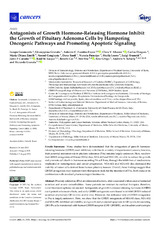Mostrar el registro sencillo del ítem
Antagonists of Growth Hormone-Releasing Hormone Inhibit the Growth of Pituitary Adenoma Cells by Hampering Oncogenic Pathways and Promoting Apoptotic Signaling
| dc.contributor.author | Gesmundo, Iacopo | |
| dc.contributor.author | Granato, Giuseppina | |
| dc.contributor.author | Fuentes-Fayos, Antonio C. | |
| dc.contributor.author | Álvarez, Clara V. | |
| dc.contributor.author | Diéguez, Carlos | |
| dc.contributor.author | Zatelli, Maria Chiara | |
| dc.contributor.author | Congiusta, Noemi | |
| dc.contributor.author | Banfi, Dana | |
| dc.contributor.author | Prencipe, Nunzia | |
| dc.contributor.author | Leone, Sheila | |
| dc.contributor.author | Brunetti, Luigi | |
| dc.contributor.author | Castaño, Justo P. | |
| dc.contributor.author | Luque, Raúl M. | |
| dc.contributor.author | Cai, Renzhi | |
| dc.contributor.author | Sha, Wei | |
| dc.contributor.author | Ghigo, Ezio | |
| dc.contributor.author | Schally, Andrew V. | |
| dc.contributor.author | Granata, Riccarda | |
| dc.date.accessioned | 2021-09-27T11:54:46Z | |
| dc.date.available | 2021-09-27T11:54:46Z | |
| dc.date.issued | 2021 | |
| dc.identifier.uri | http://hdl.handle.net/10396/21660 | |
| dc.description.abstract | Pituitary adenomas (PAs) are intracranial tumors, often associated with excessive hormonal secretion and severe comorbidities. Some patients are resistant to medical therapies; therefore, novel treatment options are needed. Antagonists of growth hormone-releasing hormone (GHRH) exert potent anticancer effects, and early GHRH antagonists were found to inhibit GHRH-induced secretion of pituitary GH in vitro and in vivo. However, the antitumor role of GHRH antagonists in PAs is largely unknown. Here, we show that the GHRH antagonists of MIAMI class, MIA-602 and MIA-690, inhibited cell viability and growth and promoted apoptosis in GH/prolactin-secreting GH3 PA cells transfected with human GHRH receptor (GH3-GHRHR), and in adrenocorticotropic hormone ACTH-secreting AtT20 PA cells. GHRH antagonists also reduced the expression of proteins involved in tumorigenesis and cancer progression, upregulated proapoptotic molecules, and lowered GHRH receptor levels. The combination of MIA-690 with temozolomide synergistically blunted the viability of GH3-GHRHR and AtT20 cells. Moreover, MIA-690 reduced both basal and GHRH-induced secretion of GH and intracellular cAMP levels. Finally, GHRH antagonists inhibited cell viability in human primary GH- and ACTH-PA cell cultures. Overall, our results suggest that GHRH antagonists, either alone or in combination with pharmacological treatments, may be considered for further development as therapy for PAs. | es_ES |
| dc.format.mimetype | application/pdf | es_ES |
| dc.language.iso | eng | es_ES |
| dc.publisher | MDPI | es_ES |
| dc.rights | https://creativecommons.org/licenses/by/4.0/ | es_ES |
| dc.source | Cancers 13(16), 3950 (2021) | es_ES |
| dc.subject | GHRH | es_ES |
| dc.subject | GH-secreting pituitary adenoma | es_ES |
| dc.subject | ACTH-secreting pituitary adenomas | es_ES |
| dc.subject | Cell viability | es_ES |
| dc.subject | Apoptosis | es_ES |
| dc.title | Antagonists of Growth Hormone-Releasing Hormone Inhibit the Growth of Pituitary Adenoma Cells by Hampering Oncogenic Pathways and Promoting Apoptotic Signaling | es_ES |
| dc.type | info:eu-repo/semantics/article | es_ES |
| dc.relation.publisherversion | https://doi.org/10.3390/cancers13163950 | es_ES |
| dc.relation.projectID | Gobierno de España. PID2019-105564RB-I00 | es_ES |
| dc.relation.projectID | Gobierno de España. PID2019-105201RB-I00 | es_ES |
| dc.rights.accessRights | info:eu-repo/semantics/openAccess | es_ES |

